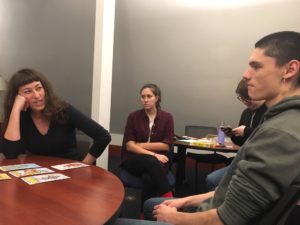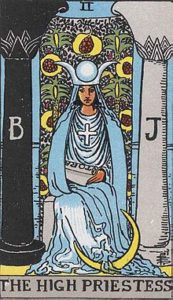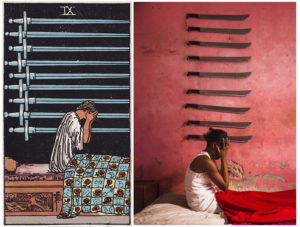Jen Katz ’19
As the sun set over a snowy campus on the evening of Wednesday, November 14, the Old Main 4th floor lounge was bathed in golden light. Darkness slowly fell over the room, and a group of students settled down with Italian sodas and popcorn to learn about the mystical history of tarot from Professor Emma Törzs.

Her talk was the latest in the Pop Talk series, in which English professors offer their insights on a pop culture topic of their choice and engage students in discussion over popcorn. Professor Törzs, who taught herself tarot reading as a teenager and used to read tarot cards professionally, brought a special level of expertise to her discussion. The assembled students learned about the history of tarot cards, the meaning of each card, and their uses. We also addressed the big question: is any of it “real”?
What we know today as tarot cards, Professor Törzs explained, were originally used as playing cards in 15th-century Europe, a phenomenon that originated in Egypt. Hebrew mysticism, pagan mythology, and Christian symbolism all contribute to the traditional imagery of the tarot deck. The cards were used to play the game of tarocchi, which people still play a modified form of today in European countries. Fortune tellers likely only began using tarot cards for divination in the 18th century.
The structure of the tarot deck is complicated, but broadly, it’s divided into major and minor arcana. The minor arcana still resemble playing cards in that they are separated into four suits—wands, cups, pentacles, and swords—and the cards range from one to ten with four “face” cards. Each of these cards has its own significance, but the major arcana are packed with even more meaning. The 22 major arcana cards represent steps of the archetypal hero’s journey, starting with The Fool and ending at The World. While every card has associated connotations, each tarot reader brings their own interpretations to their readings.

The most commonly used tarot deck is known as the Rider-Waite deck, first designed in 1910 by English artist Pamela Colman Smith at the instruction of occultist A. E. Waite. This deck’s images are the well-known art nouveau-inspired depictions of bright yellow suns and figures painted in flat colors in strange, almost surreal situations. Professor Törzs described the Rider-Waite deck as “extremely white and extremely heteronormative,” and said that those traditional gender dynamics especially can affect the interpretation of the cards in readings.
The conventional Rider-Waite deck is far from the only interpretation of tarot imagery, though. Two avant-garde interpretations that Professor Törzs presented were the Slow Holler deck, which is a more abstract interpretation of the meanings of the cards by a collective of Southern, queer-identified artists, and the Ghetto Tarot deck, which features photographic recreations of the Rider-Waite images by a group of Haitian artists. Both decks are part of an effort to establish a cultural place within the practice of tarot divination for marginalized groups and to make it relevant to groups who aren’t represented in the Eurocentric deck.
As someone who once read tarot cards professionally, Professor Törzs has grappled with the question of whether tarot cards hold any true predictive power: in short, if they’re “real.”

“I have no way of answering that. I really don’t know. I’ve had experiences with tarot that are inexplicable to me, but also, when I sit down to read someone’s cards, I’m also reading that person,” she said. “I’m reading their minute reactions to the things that I’m saying, if they lean forward, if their eye twitches when I mention a relationship, something like that.
“I’ve had strangers weeping in my arms,” she continued. “It’s a really beautiful way to get to know people. Reading somebody’s tarot cards is a weird and intimate experience. I don’t know if it’s real. I don’t use it as prediction. To me, it’s more helpful as a lens through which to look at a problem. It gives you a different way to look at something.”
That reframing lens can be useful to the craft of writing, according to Professor Törzs.
“It’s a really fun tool for inspiration in art… I have literally asked questions that are like, ‘What does my character want in this scene?’ And I’ll draw a set of cards and be like, oh yeah, that makes total sense. It’s often really helpful because it forces your mind to do a little skip and a jump,” she said.
Who can really say if the mystical power of divination is real? When asked if she believes in a divine power behind her readings, Professor Törzs said that, “Sometimes it feels like there is, sometimes it feels like it’s all imaginary.” The power behind the cards may or may not be divine, but regardless, their continued use and their reinvention by different communities shows that the power definitely exists.